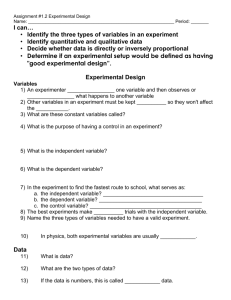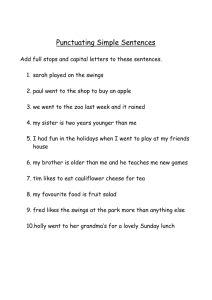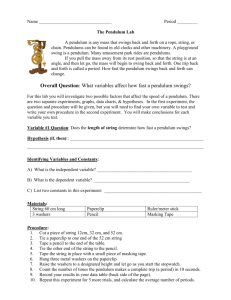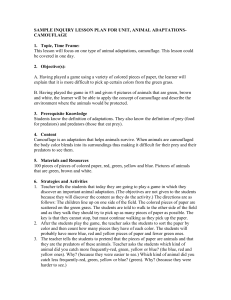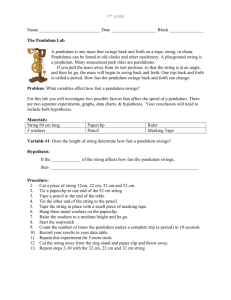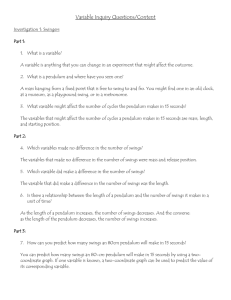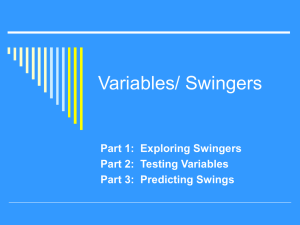Pendulum Lab Name
advertisement
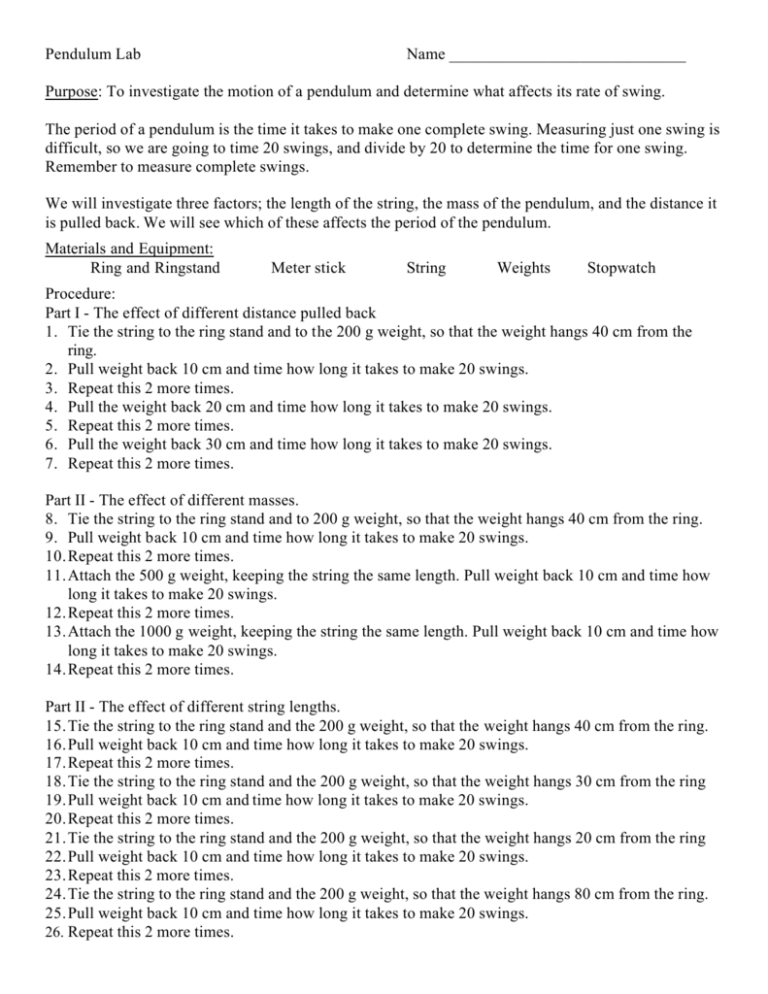
Pendulum Lab Name _____________________________ Purpose: To investigate the motion of a pendulum and determine what affects its rate of swing. The period of a pendulum is the time it takes to make one complete swing. Measuring just one swing is difficult, so we are going to time 20 swings, and divide by 20 to determine the time for one swing. Remember to measure complete swings. We will investigate three factors; the length of the string, the mass of the pendulum, and the distance it is pulled back. We will see which of these affects the period of the pendulum. Materials and Equipment: Ring and Ringstand Meter stick String Weights Stopwatch Procedure: Part I - The effect of different distance pulled back 1. Tie the string to the ring stand and to the 200 g weight, so that the weight hangs 40 cm from the ring. 2. Pull weight back 10 cm and time how long it takes to make 20 swings. 3. Repeat this 2 more times. 4. Pull the weight back 20 cm and time how long it takes to make 20 swings. 5. Repeat this 2 more times. 6. Pull the weight back 30 cm and time how long it takes to make 20 swings. 7. Repeat this 2 more times. Part II - The effect of different masses. 8. Tie the string to the ring stand and to 200 g weight, so that the weight hangs 40 cm from the ring. 9. Pull weight back 10 cm and time how long it takes to make 20 swings. 10. Repeat this 2 more times. 11. Attach the 500 g weight, keeping the string the same length. Pull weight back 10 cm and time how long it takes to make 20 swings. 12. Repeat this 2 more times. 13. Attach the 1000 g weight, keeping the string the same length. Pull weight back 10 cm and time how long it takes to make 20 swings. 14. Repeat this 2 more times. Part II - The effect of different string lengths. 15. Tie the string to the ring stand and the 200 g weight, so that the weight hangs 40 cm from the ring. 16. Pull weight back 10 cm and time how long it takes to make 20 swings. 17. Repeat this 2 more times. 18. Tie the string to the ring stand and the 200 g weight, so that the weight hangs 30 cm from the ring 19. Pull weight back 10 cm and time how long it takes to make 20 swings. 20. Repeat this 2 more times. 21. Tie the string to the ring stand and the 200 g weight, so that the weight hangs 20 cm from the ring 22. Pull weight back 10 cm and time how long it takes to make 20 swings. 23. Repeat this 2 more times. 24. Tie the string to the ring stand and the 200 g weight, so that the weight hangs 80 cm from the ring. 25. Pull weight back 10 cm and time how long it takes to make 20 swings. 26. Repeat this 2 more times. Hypothesis: Before you begin the lab, answer the following questions. 1. What do you think the effect of pulling back further will be on the period of the pendulum and WHY? 2. What do you think the effect of adding more weights will be on the period of the pendulum and WHY? 3. What do you think the effect of lengthening the string will be on the period of the pendulum and WHY? Conclusion: Answer the following questions AFTER completing the laboratory. 4. Describe the effect pulling the weight back further had on the period of the pendulum. 5. Describe the effect adding weights had on the period of the pendulum. 6. Describe the effect a longer string had on the period of the pendulum. 7. Were your hypotheses supported by this experiment? Explain your answers. Data Tables Part I Distance Pulled Back 10 cm 20 cm 30 cm Time for 20 swings Trial 1 Trial 2 Trial 3 Trial 1 Trial 2 Trial 3 Trial 1 Trial 2 Trial 3 Average Period for one swing Time for 20 swings Trial 1 Trial 2 Trial 3 Trial 1 Trial 2 Trial 3 Trial 1 Trial 2 Trial 3 Average Period for one swing Time for 20 swings Trial 1 Trial 2 Trial 3 Trial 1 Trial 2 Trial 3 Trial 1 Trial 2 Trial 3 Trial 1 Trial 2 Trial 3 Average Period for one swing Part II Weights 200 g 500 g 1000 g Part III Length of String 40 cm 30 cm 20 cm 80 cm
